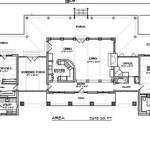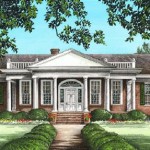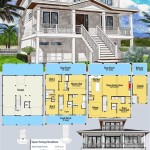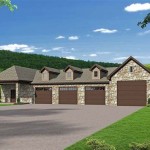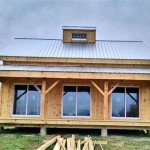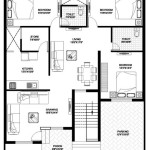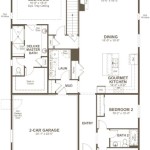Bi-Level Home Floor Plans: An In-Depth Exploration
Bi-level homes, sometimes referred to as split-level entry homes, present a unique architectural style that offers distinct advantages and disadvantages. These homes are characterized by a design where the main living areas are situated on two levels, with a short set of stairs leading from the entry to both the upper and lower levels. This design configuration distinguishes bi-level homes from traditional two-story homes and ranch-style homes. Understanding the intricacies of bi-level home floor plans is crucial for potential buyers, builders, and remodelers.
The bi-level design emerged as a popular housing option in the mid-20th century, particularly during post-World War II suburban development. Its appeal stemmed from its cost-effectiveness in construction and its ability to maximize living space on smaller lots. The design allowed for a separation of living and sleeping areas, often with the bedrooms located on one level and the living room, dining room, and kitchen on another. Furthermore, the lower level frequently included a recreational space, laundry area, and often an additional bathroom, effectively increasing the functional square footage of the home.
One of the defining characteristics of bi-level homes is the entry foyer, which is typically located midway between the upper and lower levels. This entry immediately splits the traffic flow, offering immediate access to both the main living spaces and the lower level. The design allows for a sense of separation and privacy between the different zones of the house, which can be particularly advantageous for families with diverse needs or those who frequently entertain guests. However, the design also presents some challenges, particularly with regards to accessibility and the perceived lack of a grand entrance.
Key Point 1: Architectural Features and Layout Variations
Bi-level homes generally feature a symmetrical or near-symmetrical facade, often with a rectangular footprint. The rooflines are typically simple, such as gable roofs or hip roofs, reflecting the mid-century modern aesthetic prevalent during their initial construction phase. The exterior materials vary widely and can include brick, siding, stone veneer, or a combination thereof. Windows are strategically positioned to provide natural light to both the upper and lower levels. Common variations within the bi-level design include slightly offset levels or modifications to the entry foyer to create a more welcoming space.
The layout of a bi-level home typically places the main living spaces—living room, dining room, and kitchen—on the upper level. This arrangement offers elevated views and can create a more open and airy feel. The bedrooms, including the master suite and any additional bedrooms, are also often located on the upper level, providing a dedicated sleeping area. The lower level is usually reserved for more casual activities and often includes a family room, recreation room, or home office. This level may also house laundry facilities, storage spaces, and potentially a guest bedroom or bathroom. The configuration of the lower level can vary significantly depending on the specific floor plan and the desired functionality of the space.
One common variation involves a partially finished lower level. In these instances, the unfinished area may serve as a utility space, workshop, or additional storage area. The finished portion typically connects to the main living space and offers a greater sense of integration between the two levels. Another variation involves a walk-out basement, which provides direct access to the backyard from the lower level. This feature is particularly desirable for homes situated on sloping lots and allows for improved natural light and ventilation in the lower level.
Accessibility is an important consideration in bi-level home design. The presence of stairs between the entry and both the upper and lower levels can pose challenges for individuals with mobility limitations. While some bi-level homes may incorporate ramps or elevators to improve accessibility, these modifications are not always feasible or aesthetically desirable. Therefore, careful consideration of accessibility needs is crucial when evaluating a bi-level home or designing a new bi-level floor plan.
Key Point 2: Advantages and Disadvantages of Bi-Level Homes
Bi-level homes offer several advantages that contribute to their enduring appeal. One of the main benefits is cost-effectiveness. The simplified construction process and efficient use of materials often result in lower construction costs compared to traditional two-story homes. This affordability makes bi-level homes an attractive option for first-time homebuyers or those with budget constraints. Additionally, bi-level homes can maximize usable living space on smaller lot sizes. The split-level design allows for a greater floor area compared to ranch-style homes, while still maintaining a relatively compact footprint.
The separation of living spaces is another significant advantage. The division between the upper and lower levels allows for greater privacy and noise control. This can be particularly beneficial for families with children or those who work from home. The lower level can serve as a dedicated recreation area or home office, minimizing disruptions to the main living spaces on the upper level. This segregation of zones can contribute to a more comfortable and functional living environment.
However, bi-level homes also have certain disadvantages that should be carefully considered. One common drawback is the entryway. The split-level entry can feel cramped and uninviting, lacking the grandeur of a traditional foyer. The immediate presence of stairs can also be a deterrent for some homeowners, especially those with young children or elderly family members. The limited amount of natural light in the lower level is another potential disadvantage. Depending on the orientation of the home and the size of the windows, the lower level can feel darker and less inviting than the upper level.
Resale value is another factor to consider. Bi-level homes may not be as universally desirable as other architectural styles, such as traditional two-story homes or updated ranch-style homes. This can potentially impact the resale value of the property. However, this can vary significantly depending on the location, the condition of the home, and the overall market trends. A well-maintained and updated bi-level home in a desirable neighborhood can still command a competitive price.
Key Point 3: Renovation and Remodeling Considerations
Renovating a bi-level home can present unique challenges and opportunities. Many homeowners opt to modernize the interior and exterior of their bi-level homes to enhance their aesthetic appeal and improve functionality. Common renovation projects include updating kitchens and bathrooms, refinishing floors, and replacing windows and doors. The goal is often to create a more open and contemporary living space while retaining the essential characteristics of the bi-level design.
One frequent renovation project involves reconfiguring the entry foyer. Homeowners may choose to expand the foyer, add a coat closet, or install a new front door to create a more welcoming entrance. Other common projects include improving the natural light in the lower level by adding larger windows or installing light wells. Reconfiguring the layout of the lower level can also improve the functionality of the space, such as adding a new bathroom or creating a dedicated home office.
Exterior renovations can also significantly enhance the curb appeal of a bi-level home. Replacing siding, adding a front porch, or landscaping the yard can transform the appearance of the property. New windows and doors can also improve the energy efficiency of the home, reducing heating and cooling costs. In some cases, homeowners may even consider adding a second story to a bi-level home, effectively converting it into a traditional two-story structure. However, this type of renovation is typically more complex and expensive.
When renovating a bi-level home, it is important to carefully consider the structural integrity of the building. Modifications to load-bearing walls or the foundation can have significant consequences and should only be undertaken by qualified professionals. It is also essential to obtain the necessary permits and approvals from local building authorities to ensure compliance with building codes. A well-planned and executed renovation can significantly enhance the value and functionality of a bi-level home, transforming it into a comfortable and stylish living space.
Ultimately, the decision of whether to buy, build, or renovate a bi-level home depends on individual preferences, needs, and financial considerations. Understanding the unique characteristics of this architectural style, as well as its advantages and disadvantages, is crucial for making an informed decision. With careful planning and attention to detail, a bi-level home can provide a comfortable and affordable living environment.

Familyhomeplans Com Plan Number 45253 Order Code 01web Split Level House Plans Modular Home Floor

4 Bedroom Split Level House Plan 2136 Sq Ft 2 Bathroom

Split Level House Plans And Foyer Floor

Plan 8963ah Split Level Home Floor Plans House Remodeling

Modern Split Level House Plans And Multi Floor Plan Designs

Split Level House Plans Home Design 3266

Split Level Home Plan For Narrow Lot 23444jd Architectural Designs House Plans

Split Level House Plans And Foyer Floor

House Plan 80466 Traditional Style With 1150 Sq Ft 3 Bed 1 Ba
Split Level Homes Designs G J Gardner

